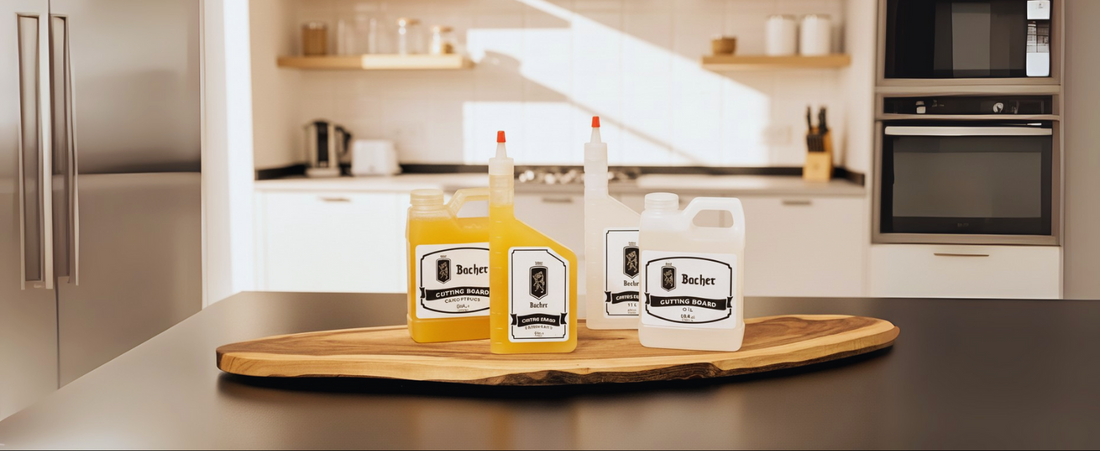Wooden boards, accessories and worktops can last for years with the right protection, and it's not at all complicated. All you need is two products: oil to start with and a conditioner to incorporate into your routine. Learn how to effortlessly select the appropriate product for each situation and gradually achieve a beautiful, hygienic, moisture-resistant finish.
Having wood in the kitchen brings warmth and character, but also a little responsibility. Chopping boards, trays, spoons and even worktops will serve you well for years if you regularly impregnate them with oil and refresh them with wood conditioner. Read on for a clear guide on how these products differ, when to use them, and how to use them correctly to keep the wood hygienic, beautiful, and moisture-resistant.
Oil vs. conditioner: the most important differences
Let's start with the basics: these two products have different functions, but they complement each other perfectly.
- Oil penetrates deep into the wood structure, saturating the fibres and building long-lasting resistance to moisture and grease absorption. It is ideal for initial deep impregnation and for providing a solid protective base.
- Conditioner does not penetrate as deeply as pure oil, but it refreshes and 'seals' the surface, giving it a pleasant shine and smoothness.
Practical protective effect:
- The wood conditioner copes better with short, occasional contact with moisture or juices (e.g. eating a hot steak quickly from a serving board – short ageing time).
- Thanks to its deep penetration, oil provides better protection against prolonged contact (e.g. with sliced tomatoes that 'release' juice and remain on the board throughout the meal).
The golden rule:
Oil is used for the initial deep impregnation. Use a conditioner for regular top-ups (e.g. every month).
When to choose oil? When to choose conditioner?
This decision can be made in a minute — just consider the condition of the surface and how it will be used.
Choose oil when:
- You are installing a new board, accessory or worktop.
- The wood is 'thirsty': it is dull and rough and absorbs water quickly (a drop of water does not bead up, but is absorbed).
- You are preparing the wood for more intensive use and potentially longer contact with moisture.
Choose a conditioner when:
- You want to quickly refresh the appearance and smoothness of the surface.
- The wood already has a base impregnation and you want to maintain it.
- The accessories are mainly used for serving (short, occasional contact with moisture or grease).
The best duo in practice:
- Start with: Apply 2–4 coats of oil depending on absorbency.
- For routine maintenance, apply a light conditioner every 2–4 weeks for boards and accessories, and every 1–2 months for worktops (or more frequently if used intensively).
Step-by-step oiling:
Good oiling accounts for 80% of success. Apply oil for wood care in thin layers, making sure to wipe off any excess.

- Washing and drying: wash the surface with a mild liquid, then rinse and dry completely (for at least a few hours, or preferably overnight). If the wood has come into contact with grease, wash it with a mild detergent, then rinse and dry it.
- Applying oil: use one to two teaspoons per board (more for countertops) to apply a thin, even layer. Use a lint-free cloth or pad. Rub in circular motions, then 'along the grain'.
- Wait: leave for 15–30 minutes until the wood has absorbed the product.
- Wipe off any excess: until the wood is dry (it is important to do this thoroughly, as excess oil will stick and attract dirt).
Repeat the treatment after 12–24 hours. Usually, two to three coats are sufficient. For very absorbent species, the curing time is 24–48 hours for a 'working' surface and 3–7 days for full resistance.
Special tips:
- Edges and ends (grain tips) absorb the most, so pay more attention to these areas.
- For tabletops, consider 'saturating' the first two coats (you can apply more product, but always wipe off any excess).

Conditioner: quick refreshment and 'sealing'.
This quick treatment instantly restores smoothness and water repellency.
When?
When the surface loses its silky smoothness and starts to absorb water, or when pale, dry patches appear. It's also ideal for freshening up your board or worktop before weekend cooking.
How?
- Apply a very thin layer of conditioner to a clean, dry surface.
- Polish with the included chamois cloth, moving along the grain.
- Leave for 15–30 minutes, then wipe dry.
- It's ready almost immediately, making it the perfect treatment 'before guests arrive'.
Frequency:
- Boards and accessories: every 2–4 weeks (or after each thorough clean).
- Worktops: once or twice a month, depending on how often they are used.
The most common mistakes (and how to avoid them):
These are the mistakes we make most often, but you can easily avoid them by remembering a few simple rules.
- Applying too thick a layer of oil results in a sticky, tarry surface. Always wipe off the excess after 15–30 minutes.
- Infrequent refreshing: the wood becomes dull and absorbs moisture and odours more quickly. Introduce a simple routine, e.g. the first Saturday of the month.
- Using the wrong chemicals → aggressive detergents destroy the coating.
- Use mild cleaning products and avoid soaking or putting the wood in the dishwasher.
- Using inappropriate oils can cause edible oils (e.g. rapeseed oil) to go rancid. Choose oils that are suitable for food contact.
- If you apply to damp wood, water will be trapped inside. Always ensure 100% dryness before impregnation.
- Mixing preparations without testing them first may result in some finishes ‘clashing’. If you are changing products, test them on an inconspicuous area first.
Summary:
To keep the wood in your kitchen smooth, hygienic and moisture-resistant, follow these two simple routines. First, use oil for deep initial impregnation and periodic 'reset' protection. Then, use a conditioner regularly to quickly refresh and 'seal' the surface between oilings. You will find a comprehensive range of oils and conditioners for this purpose in the ‘Wood Care’ collection in our shop.


